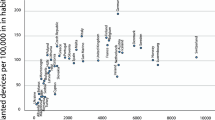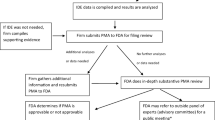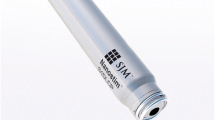Abstract
Post-market evaluation is important to ensure the ongoing safety and effectiveness of cardiovascular implantable electronic device (CIED) leads. The Twenty-First Century Cures Act and subsequent Food and Drug Administrative (FDA) Guidance provide an opportunity to leverage real-world data sources for this purpose. The past 4 years have seen the development of EP PASSION: a multi-stakeholder, collaborative effort between the FDA, CIED manufacturers, Heart Rhythm Society, and academics. Using real-world data, EP PASSION enables longitudinal evaluation of the long-term safety of CIED leads, addressing limitations of current approaches to generate evidence that informs regulatory, clinical, and manufacturer decision-making. This state of the art article describes the impetus for and launch of EP PASSION, the lessons learned, its current state, the current analytic approach, and the strengths and limitations of leveraging extant data sources for post-market lead evaluation. We also compare EP PASSION to traditional post-approval studies and describe possible future directions.


Similar content being viewed by others
Explore related subjects
Discover the latest articles and news from researchers in related subjects, suggested using machine learning.References
Epstein AE, DiMarco JP, Ellenbogen KA, Estes NA 3rd, Freedman RA, Gettes LS, et al. ACC/AHA/HRS 2008 guidelines for device-based therapy of cardiac rhythm abnormalities: a report of the American College of Cardiology/American Heart Association Task Force on Practice Guidelines (Writing Committee to Revise the ACC/AHA/NASPE 2002 Guideline Update for Implantation of Cardiac Pacemakers and Antiarrhythmia Devices) developed in collaboration with the American Association for Thoracic Surgery and Society of Thoracic Surgeons. J Am Coll Cardiol. 2008;51(21):e1-62.
Epstein AE, DiMarco JP, Ellenbogen KA, Estes NA 3rd, Freedman RA, Gettes LS, et al. 2012 ACCF/AHA/HRS focused update incorporated into the ACCF/AHA/HRS 2008 guidelines for device-based therapy of cardiac rhythm abnormalities: a report of the American College of Cardiology Foundation/American Heart Association Task Force on Practice Guidelines and the Heart Rhythm Society. J Am Coll Cardiol. 2013;61(3):e6-75.
Kusumoto FM, Schoenfeld MH, Barrett C, Edgerton JR, Ellenbogen KA, Gold MR, et al. 2018 ACC/AHA/HRS guideline on the evaluation and management of patients with bradycardia and cardiac conduction delay: executive summary: a report of the American College of Cardiology/American Heart Association Task Force on Clinical Practice Guidelines, and the Heart Rhythm Society. J Am Coll Cardiol. 2019;74(7):932–87.
Zeitler EP, Selzman KA. Defibrillator lead survival: where is the threshold? Circ Cardiovasc Qual Outcomes. 2020;13(4):e006649.
Food and Drug Administration. Mandatory reporting requirements: manufacturers, importers and device user facilities [Available from: https://www.fda.gov/medical-devices/postmarket-requirements-devices/mandatory-reporting-requirements-manufacturers-importers-and-device-user-facilities.
Food and Drug Administration. MAUDE - Manufacturer and User Facility Device Experience [Available from: http://www.accessdata.fda.gov/scripts/cdrh/cfdocs/cfmaude/search.cfm.
21st Century Cures Act, Pub. L. No. PL 114–255 (December 13, 2016, December 13, 2016).
Sherman RE, Anderson SA, Dal Pan GJ, Gray GW, Gross T, Hunter NL, et al. Real-world evidence - what is it and what can it tell us? N Engl J Med. 2016;375(23):2293–7.
Food and Drug Administration. Use of real-world evidence to support regulatory decision-making for medical devices August 31, 2017 [Available from: https://www.fda.gov/media/99447/download.
PART 821 Medical Device Tracking Requirements. Subpart B - tracking requirements. § 821.25 - Device tracking system and content requirements: manufacturer requirements.
Food and Drug Administration. Medical device tracking: guidance for industry and Food and Drug Administration Staff [Available from: https://www.fda.gov/media/71205/download.
Ranasinghe I, Parzynski CS, Freeman JV, Dreyer RP, Ross JS, Akar JG, et al. Long-term risk for device-related complications and reoperations after implantable cardioverter-defibrillator implantation: an observational cohort study. Ann Intern Med. 2016;165(1):20–9.
Koneru JN, Jones PW, Hammill EF, Wold N, Ellenbogen KA. Risk factors and temporal trends of complications associated with transvenous implantable cardiac defibrillator leads. J Am Heart Assoc. 2018;7(10).
Food and Drug Administration. IRB waiver or alteration of informed consent for clinical investigations involving no more than minimal risk to human subjects [Available from: https://www.fda.gov/media/106587/download.
Hicks J, Keith M, Moll P, Simeles J, Offer ECD, et al. Novel method to identify lead complications in pacemaker systems from real-world data: proof of concept for the Siello S pacing lead. Heart Rhythm. 2019;16(5):S260–1.
Collins T, Miller CD, Chen Z, Sharmin K, Hicks J. Transition of post-approval study reporting for the Siello S pacing lead to real-world data methodology. Heart Rhythm. 2020;17(5):S193–4.
Chatterjee S, Gillett S, Miller C, Kazi S, Chen Z, Hicks J. Real-world evidence of sentus quadripolar lead safety. Heart Rhythm. 2020;17(5):S197.
Food and Drug Administration. Evaluation and reporting of age, race, and ethnicity data in medical device clinical studies 2017 [Available from: https://www.fda.gov/media/98686/download.
Food and Drug Administration. Evaluation of sex-specific data in medical device clinical studies: guidance for industry and Food and Drug Administration Staff 2014 [
Coca SG, Krumholz HM, Garg AX, Parikh CR. Underrepresentation of renal disease in randomized controlled trials of cardiovascular disease. JAMA. 2006;296(11):1377–84.
Masoudi FA, Ponirakis A, de Lemos JA, Jollis JG, Kremers M, Messenger JC, et al. Trends in U.S. Cardiovascular care: 2016 report from 4 ACC National Cardiovascular Data Registries. J Am Coll Cardiol. 2017;69(11):1427–50.
Shuren J, Califf RM. Need for a national evaluation system for health technology. JAMA. 2016;316(11):1153–4.
Zeitler EP, Al-Khatib SM, Drozda JP Jr, Kessler LG, Kirtane AJ, Kong DF, et al. Predictable and SuStainable Implementation of National Cardiovascular Registries (PASSION) infrastructure: a think tank report from Medical Device Epidemiological Network Initiative (MDEpiNet). Am Heart J. 2016;171(1):64-72 e1-2.
Kaiser Family Foundation. A dozen facts about Medicare advantage in 2019 [Available from: https://www.kff.org/medicare/issue-brief/a-dozen-facts-about-medicare-advantage-in-2019/.
Dhruva SS, Ross JS, Schulz WL, Krumholz HM. Fulfilling the promise of unique device identifiers. Ann Intern Med. 2018;169(3):183–5.
Food and Drug Administration. Patient preference information (PPI) in medical device decision-making [Available from: https://www.fda.gov/about-fda/cdrh-patient-engagement/patient-preference-information-ppi-medical-device-decision-making.
Author information
Authors and Affiliations
Corresponding author
Ethics declarations
Ethics approval
Ethical approval was not required for this manuscript.
Conflict of interest
SSD receives research funding from the Food and Drug Administration (FDA), the National Evaluation System for Health Technology Coordinating Center (NESTcc), the National Heart, Lung, and Blood Institute (NHLBI) of the National Institutes of Health (NIH) (K12HL138046), the National Institute for Healthcare Management, Arnold Ventures, and the Greenwall Foundation. YN is an employee and owns stock of Abbott. VS is an employee of Boston Scientific. SM is an employee of Biotronik. LZ was an employee of Medtronic. EPZ provides consulting services to Medtronic Inc and receives research funding from Boston Scientific and the National Cardiovascular Data Registry (NCDR).
Additional information
Publisher's Note
Springer Nature remains neutral with regard to jurisdictional claims in published maps and institutional affiliations.
Supplementary Information
Below is the link to the electronic supplementary material.
Rights and permissions
About this article
Cite this article
Dhruva, S.S., Zeitler, E.P., Caños, D. et al. Evaluation of cardiovascular implantable electronic device leads post implant: ElectroPhysiology Predictable And SuStainable Implementation Of National Registries (EP PASSION). J Interv Card Electrophysiol 66, 997–1004 (2023). https://doi.org/10.1007/s10840-022-01189-x
Received:
Accepted:
Published:
Issue Date:
DOI: https://doi.org/10.1007/s10840-022-01189-x




